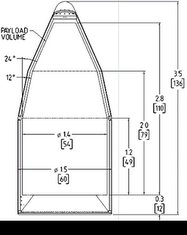To carry the payload consisting of the Lunar Base Station and the Lunar Rover from the Earth's surface to the Moon, a launch vehicle or a carrier rocket is essential. A launch system includes the launch vehicle, the launch pad and other infrastructure. For the GoogleXprize mission the Falcon launch vehicle designed by SpaceX technologies has been selected. It provides the velocity needed by the lunarcraft (base station and the moon rover) to escape Earth's gravity and set it on its course for Moon.
Falcon 1 is a two stage, liquid oxygen and rocket grade kerosene (RP-1) powered launch vehicle.
Length: 21.3 m (70 ft)Width: 1.7 m (5.5 ft)
Mass: 38,555 kg (85klbs)
Thrust on liftoff: 454 kN (102 klbf)
Fig 1 Falcon1
First Stage:
The primary structure is made of a space grade aluminum alloy in a patent pending, graduated monocoque, common bulkhead, flight pressure stabilized architecture developed by SpaceX.A single SpaceX Merlin engine powers the Falcon 1 first stage. After engine start, Falcon is held down until all vehicle systems are verified to be functioning normally before release for liftoff.Stage separation occurs via dual initiated separation bolts and a pneumatic pusher system.The first stage returns by parachute to a water landing, where it is picked up by ship in a procedure similar to that of the Space Shuttle solid rocket boosters.
Second Stage:
The tank structure is made of aluminum-lithium, an alloy possessing the highest strength to weight ratio of any aluminum.The tanks are precision machined from thick plate with integral flanges and ports, minimizing the number of welds necessary. The major circumferential welds are all done by an automated welding machine, reducing the potential for error and ensuring consistent quality.A single SpaceX Kestrel engine powers the Falcon 1 upper stage. A highly reliable and proven TEA-TEB pyrophoric system is used to provide multiple restart capability on the upper stage.
Stage separation reliability:
Here Falcon takes advantage of simplicity by having two stages and therefore only one stage separation event – the minimum practical number. Moreover, the stage separation bolts are all dual initiated, fully space qualified and have a zero failure track record in prior launch vehicles.
Fairing Volume:
Below are the standard fairing dimensions for Falcon 1 Launch Vehicles. Dimensions are in meters and in inches inside the parentheses.
Fig 2 Falcon 1 Fairing
Flight profile:
The LunarCraft would be initially launched in a geosynchronous orbit . After a quick estimate of the achieved LTT
(Lunar Transfer Trajectory) a mid-course correction will be imparted and the lunarcraft would be inserted into a elliptical transfer orbit. The lunarcraft coasts for about six days in this trajectory prior to the lunar encounter. The major maneuver of the mission caused by firing rockets, transfer it to a circular orbit with a radius of 2,147 km around the moon. The platform with the rover will detach itself off after the spacecraft reaches its orbit above the moon, and land on the lunar surface. A motorised rover will be released on the moon's surface from the platform.(For more details on the orbital path please check the Orbital Mechanics link)


